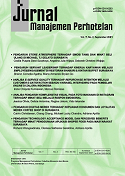PENGARUH SERVANT LEADERSHIP TERHADAP KINERJA KARYAWAN MELALUI EMPLOYEE ENGAGEMENT DI RESTORAN SHABURI & KINTAN BUFFET SURABAYA
DOI:
https://doi.org/10.9744/jmp.7.2.63-74Keywords:
Servant Leadership, Employee Engagement, Employee Performance, Shaburi Restaurant and Kintan BuffetAbstract
Company leaders are responsible for improving employee performance by increasing employee involvement on the job. The right leadership style enhances employee performance because it causes employees to feel motivated. This study aims to explain the influence of servant leadership on employee performance through employee engagement at Shaburi & Kintan Buffet Restaurants in Surabaya. This type of research is quantitative research, and research variables include servant leadership, employee engagement, and employee performance. The number of samples is 60 employees. The data collection techniques used a questionnaire. The data analysis technique used a structural equation model with the PLS. This study's findings indicate that servant leadership directly affects employee engagement but does not directly affect employee performance. On the other hand, employee engagement directly affects employee performance. Therefore, employee engagement is a variable that mediates the influence of servant leadership on employee performance.
Abstrak
Pimpinan perusahaan memiliki tanggung jawab meningkatkan kinerja karyawan dengan meningkatkan keterlibatan karyawan pada pekerjaan. Gaya kepemimpinan yang tepat dinilai akan mampu meningkatkan kinerja karyawan karena menyebabkan karyawan merasa termotivasi. Tujuan penelitian ini adalah menjelaskan pengaruh servant leadership terhadap kinerja karyawan melalui employee engagement pada Restoran Shaburi & Kintan Buffet di Surabaya. Jenis penelitian adalah penelitian kuantitatif, variabel penelitian meliputi: servant leadership, employee engagement, dan kinerja karyawan. Jumlah sampel sebanyak 60 karyawan. Teknik pengumpulan data menggunakan kuesioner. Teknik analisis data menggunakan structural equation model dengan program PLS. Temuan penelitian ini menunjukkan: servant leadership berpengaruh secara langsung terhadap employee engagement, tetapi tidak berpengaruh secara langsung terhadap kinerja karyawan. Employee engagement berpengaruh secara langsung terhadap kinerja karyawan. Employee engagement adalah variabel yang memediasi pengaruh servant leadership terhadap kinerja karyawan.
References
Abdillah, W., & Jogiyanto. (2015). Partial Least Square (PLS) Alternatif Structural Equation Modeling (SEM) dalam Penelitian Bisnis (1st Ed.). Penerbit Andi.
Ahmad, S., & Shahzad, K. (2011). HRM and Employee Performance: A Case of Univerity Teachers of Azad Jammu and Kashmir (AJK) in Pakistan. African Journal of Business Management, 5(13), 5249-5253.
Barbuto, J. E., & Wheeler, D. (2006). Scale Development and Construct Clarification of Servant Leadership. Journal of Group and Organization Management, 31(3), 300-326. https://doi.org/10. 1177/1059601106287091
Bedarkar, M., & Pandita, D. (2014). A Study on the Drivers of Employee Engagement Impacting Employee Performance. Journal of Social and Behavioral Sciences, 133, 106-115. https://doi.org/10.1016/j.sbspro.2014.04.174
Carter, D., & Baghurst, T. (2013). The Influence of Servant Leadership on Restaurant Employee Engagement. Journal of Business Ethics, 124(3), 1-12. https://doi.org/10.1007/s10551-013-1882-0
Csikszentmihalyi, M. (1982). Beyond Boredom and Anxiety. Jossey Bass.
Greenleaf, R. K. (1973). The Servant as Leader. Center for Applied Studies.
Hair, J. e. (2010). Multivariate Data Analysis (7th ed.). Pearson.
Harwiki, W. (2016). The Impact of Servant Leadership on Organizational Culture, Organizational Commitment, Organizational Citizenship Behaviour (OCB), and Employee Performance in Women Cooperatives. Journal of Social and Behavioral Sciences, 219, 283-290.
Jagannathan, A. (2014). Determinants of Employee Engagement and Their Impact on Employee Performance. International Journal of Productivity and Performance Management, 63(3), 308-323. https://doi.org/10.1108/IJPPM-01-2013-0008
Kahn, W. A. (1990). Psychological Conditions of Personal Engagement and Disengagement at Work. The Academy of Management Journal , 33(4), 692-724. https://doi.org/10.2307/256287
Kartz, D., & Kahn, R. L. (1966). The Social Psychology of Organization. A Wiley International Edition.
Keith, K. M. (2008). The Case for Servant Leadership. Westfield, Ind.
Lisbijanto, H., & Budiyanto. (2014). Influence of Servant Leadership on Organization Performance Through Job Satisfaction in Employees Cooperatives Surabaya. International Journal of Business and Management Invention, 4(1-6), 3.
Nasution, R. (2003). Teknik Sampling. From Jurnal Perpustakaan Universitas Sumatera Utara: http://library.usu.ac.id/download/fkm/fkm-rozaini.pdf
Riyadi, M., Fakhri, M., & Winarno, A. (2020). The Effect of Servant Leadership Toward Employee Performance Through Employee Engagement as Intervening Variable. Journal of Critical Reviews, 3(4615-4621), 7.
Robbins, S. P. (1998). Organization Behavior, Concepts, Controversies, Application (7th Ed.). Engle-wood Cliffs dan PT. Prehallindo.
Robertson-Smith, G., & Markwick, C. (2009). Employee Engagement: A Review of Current Thinking. Institute for Employment Studies.
Rodwell, J. J., Kienzle, R., & Shadur, M. A. (1998). The Relationships Among Work-Related Perceptions, Employee Attitudes, and Employee Performance: The Integral Role of Communication. Journal of Human Resource Management, 37(3&4), 277-293.
Roscoe. (1975). Fundamental Research Statistics for the Behavioral Sciences. Holt, Rinehart, and Winston.
Setyaningrum, R. P., Setiawan, M., & Surachman. (2017). Organizational Commitments Are Mediation of Relationships Between Servant Leadership and Employee Performance. Jurnal Aplikasi Manajemen, 15(4), 693-701.
Simamora, P., Sudiarditha, I., & Yohana, C. (2020). The Effect of Servant Leadership on Employee Performance with Employee Engagement and Organizational Citizanship Behavior (OCB) as a Mediation Variabel in Mandiri in Health. International Journal on Advance Science, Education, and Religion, 3(13-25), 2.
Soanne, E., Truss, C., Alfes, K., Shantz, A., Rees, C., & Gatenby, M. (2012). Development and Application of a New Measure of Employee Engagement: The ISA Engagement Scale. Journal of Human Resource Development International, 15(5), 529-547. https://doi.org/10.1080/13678868.2012.726 542
Sugiyono. (2016). Metode Penelitian Kuantitatif, Kualitatif, dan R&D. Alfabeta.
Thomas, & Feldman, D. C. (2010). The Relationships of Age With Job Attitudes: A Metaanalysis. Personnel Psychology, 63(3), 677-718.
Trisnadewi, D. A. (2012). Pengaruh Kompensasi Finansial dan Kepemimpinan Terhadap Kepuasan Kerja Karyawan pada Hotel Barong Bali di Legian, Kuta Badung. Unpublished undergraduate thesis, Universitas Warmadewa Denpasar, Bali.
Wildermuth, C., & Pauken, P. D. (2008). A Perfect Match: Decoding Employee Engagement-Part I: Engaging Cultures and Leaders. Journal of Industrial and Commercial Training, 40(3), 122-128. https://doi.org/10.1108/00197850810868603



















